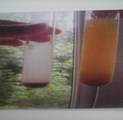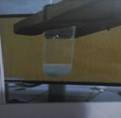Asia-Pacific Forum on Science Learning and Teaching, Volume 16, Issue 2, Article 8 (Dec., 2015) |
The application process experienced by Student 13 in Group 3 by prospective science teachers participating in the PSASL:
Group 3: Student 131. Problem statement
One of the most essential ingredients of various fizzy drinks is phosphoric acid. This component helps to protect the ingredients and enables an acidic solution.2. Identifying the problem
2.1. Sub problems
- What are other ingredients than phosphoric acid in the fizzy drinks such as coke?
- Are there any components other than phosphoric acid which provide acidic solutions in fizzy drinks?
- Are there any other components that help fizzy drinks to be preserved for a long time?
- What is the structure of phosphoric acid?
- How is phosphoric acid found in fizzy drinks such as coke?
- How does phosphoric acid affect the acidic structure of fizzy drinks such as coke?
- How does phosphoric acid help preserve acidic fizzy drinks?
- What is the reason for the bubbles that appear when fizzy drinks are opened? Is it the phosphoric acid that causes these bubbles?
- What other fields make use of phosphoric acid other than the acidic nutrition industry?
2.2. Problem Statement: How could we detect the existence of phosphoric acid in fizzy drinks such as coke?
3. Establishing Hypothesis
Technical and theoretical questions required for solving the problem;
- What is the structure and formula of phosphoric acid?
- How and why is phosphoric acid used in the nutrition industry and other industries?
- How is phosphoric acid found in coke?
- Is the proportion of phosphoric acid the same in all fizzy drinks?
- What products other than fizzy drinks like coke contain phosphoric acid?
Proposed Ways of Solution
- Determination of phosphoric acid through ascorbic acid method?
- Ion Chromatography used in determination of the phosphates found in fruit juice, milk and dairy products, fruit nectars etc.
- Phosphate determination method used for determining the existence of phosphoric acid, which is one of the primary components of detergents and is found in coke.
Experiment proposal: Phosphate determination method for determining the existence of phosphates in coke (3rd proposed solution way)
Hypothesis: Existence of phosphoric acid, which helps fizzy drinks like coke to be preserved, adds sweet taste to them and enables them to become acidic solutions, could be determined through the phosphate.
4. Trying the solution way:
The name of the experiment: Discovering Phosphates in Cola
The aim of the experiment: One of the main ingredients in many cola beverages is phosphoric acid. This compound helps to preserve the beverage, gives it part of its sweet taste, and provides an acidic solution. Phosphoric acid ionizes to a hydrogen ion, H+, and a phosphate ion, PO43-, in cola. In this activity, we will test for the presence of phosphates in cola and in common materials such as laundry detergent.
Solution and Materials:
- Cola soft drink
- Laundry detergent
- Sodium phosphate (Na3PO4) (or other phosphate salt)
- Magnesia mix
- Hydrochloric acid, 1.0M
- Test tubes, pH paper and droppers
Procedure:
- Establish a positive test for phosphate using sodium phosphate (Na3PO4).
- 0.5g of sodium phosphate is placed in a test tube. The tube is filled half full with distilled water and the tube is shaken until the solid dissolves.
- A piece of pH paper (or red litmus paper) is wetted with the solution. It should be basic.
- Hydrochloric acid is added, one drop at a time, until the solution is neutral.
- A dropper full of magnesia mix is added to the tube.
- The tube is set aside and it is observed carefully. A white precipitate that slowly forms and settles to the bottom of the tube confirms the presence of phosphate.
- Test cola for phosphate.
- The previous test is repeated, but it has been a test tube half-filled with cola instead of distilled water.
- The cola may already be acidic, so it may not be necessary to add hydrochloric acid.
- Test detergent for phosphate.
- The previous test is repeated, but a small amount of granular detergent (enough to cover a dime) is dissolved in a test tube half-filled with water.
- Be sure to test the solution with pH paper. It may be necessary to add acid to make the solution neutral.
The results of the experiment:
Phosphorus is one of the major minerals in the body. It is necessary for proper bone development, and a deficiency can cause serious defects. One of the primary sources of phosphorus is phosphates, and phosphates are in high concentration in cola beverages because of the phosphoric acid added during the bottling process. In this activity, prospective teachers will have an opportunity to first establish a qualitative test for the presence of phosphates and then use this test to show the presence of phosphates in cola and in some laundry detergents.
The questions related to the experiment:
- How did you show the presence of phosphate ions in the samples?
- Show the formula for phosphate.
- How did the amount of phosphate in the cola and the laundry detergent compare?
- Which mineral is provided by the phosphate ion?
5. Feedback: We have obtained results that verified the hypothesis I had established at the 3rd phase of the application following the experiment we had performed.
Copyright (C) 2015 HKIEd APFSLT. Volume 16, Issue 2, Article 8 (Dec., 2015). All Rights Reserved.



